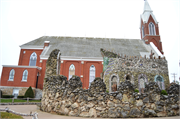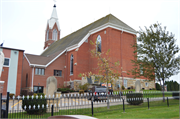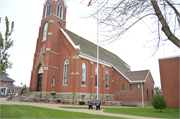Property Record
305 W MAIN ST
Architecture and History Inventory
| Historic Name: | Holy Ghost Roman Catholic Church |
|---|---|
| Other Name: | Holy Ghost Roman Catholic Church |
| Contributing: | Yes |
| Reference Number: | 55789 |
| Location (Address): | 305 W MAIN ST |
|---|---|
| County: | Grant |
| City: | Dickeyville |
| Township/Village: | |
| Unincorporated Community: | |
| Town: | |
| Range: | |
| Direction: | |
| Section: | |
| Quarter Section: | |
| Quarter/Quarter Section: |
| Year Built: | 1913 |
|---|---|
| Additions: | |
| Survey Date: | 19952016 |
| Historic Use: | house of worship |
| Architectural Style: | Early Gothic Revival |
| Structural System: | Masonry |
| Wall Material: | Brick |
| Architect: | |
| Other Buildings On Site: | |
| Demolished?: | No |
| Demolished Date: |
| National/State Register Listing Name: | Not listed |
|---|---|
| National Register Listing Date: | |
| State Register Listing Date: |
| Additional Information: | A 'site file' titled 'Holy Ghost Parish Historic District' exists for this property. It contains additional information such as correspondence, newspaper clippings, or historical information. It is a public record and may be viewed in person at the Wisconsin Historical Society, State Historic Preservation Office. 1995- "Holy Ghost Park is more well-known as the Dickeyville Grotto sculpture park. The complex is on the south side of West Main Street. Starting from the east along Main street, the first part of the complex is the gates to Holy Ghost Park. Then comes the rectory garage, then the rectory [55791], then an open space that is part of the sculpture park, then the grotto [both 44363], then the church [55789] and then the schoolhouse [55790]. The sculpture park extends southward behind the rectory and the grotto. Behind the church and the school is a large cemetery. Since this is a site with several resources, each will be discussed separately. 2016- "The district is comprised of approximately 5.3 acres, encompassing two tax parcels with multiple contributing and non-contributing resources. The Parish property currently contains the church [AHI#55789], school [55790], rectory [55791], cemetery [232926], and several utilitarian buildings. These buildings in the district represent the second generation of Parish buildings, built to accommodate a growing congregation after the first church, school, and rectory became too small or outdated. They are generally unified in appearance, despite their construction dates spanning approximately 20 years, by their red brick walls atop limestone foundations. In addition, the current Parish property contains the scattered elements of the Holy Ghost Park [44363], a series of shrines and grottos designed and constructed by Father Mathias Wernerus during his tenure as parish priest. The second tax parcel of the district contains the former convent [232925] for the teaching sisters of the school. Contributing buildings/sites The Gothic Revival Holy Ghost Church was constructed in 1913, replacing the original 1873 frame church. It was constructed with a limestone block foundation, red brick veneer and a central square tower. The front elevation faces north and features a double-door entryway in the center of the tower base, topped by a pointed arched transom window with trefoil tracery filled with stained glass. The tower rises with a series of stepped buttresses at its corners each topped with slanted stone coping. The four sides of the steeple contain louvered lancet openings which screen the church bells, and are topped with sharp gablets before the tower tapers to a four-sided point capped with a cross. Lancet stained glass windows with trefoil tracery flank each side of the entryway, and are also present on the side gabled facades of the church, separated by stepped buttresses. The exterior has been slightly altered, with the addition of a handicap entrance and modern restrooms to the western facade in 1997 and the replacement of the front entry doors. The chancel on the interior has been remodeled several times throughout the course of the church's history. However, the ceiling still includes the original rib vaulting, with the spring of each rib beginning with a highly decorative corbel of carved cherubs and grapes. The organ loft still contains the Schaefer Pipe Organ built for the church in 1939." -"Holy Ghost Parish Historic District", WISDot#1650-07-02, Prepared by UWM-CRM, (2016). Church: Red brick, Gothic Revival, 1913 (datestone) gable-roofed church. The high foundation is of rusticated limestone with a smooth beltcourse separating it from the brick above. A flight of concrete steps leads up to a tower pavilion in the center front of the church, with the main entrance inset within the tower behind a pointed arched opening. The double doors are modern replacements but the cornice of quatrefoil tracery remains above, as does the lancet transom window above that, which features delicate tracery of two lancets with a trefoil pattern and original stained and leaded glass sash. Above the door is a steeply pitched gablet of stone surmounted by a small cross. Angled buttresses at each front corner of the tower step back several times as the tower rises to the base of the steeple. On the second story of the tower above the door is a small pointed-arched window and above that window is a large lancet window with tracery and leaded and stained glass. A beltcourse separates that story from the steeple, which continues the square shape for another story. The steeple is pierced by a louvered lancet protecting the bells. Steep gablets on each side provide the transition to the steeply pointed, four-sided roof, which is covered in shingles. To each side of the main tower on the main body of the church is a very tall traceried lancet window with leaded and stained glass. Corner buttresses trim the front corners of the main block, and a line of tall brick corbels trim the eaves. Each side of the church has a row of six tall traceried lancet windows, also with the original leaded and stained glass. Shallow buttresses separate each window bay and each bay is further trimmed with molded brickwork. The apse is narrower than the main block and is square ended. On the west side of the building a small modern entrance wing has been added, blocking the bottom half of the rear lancets. The addition is sided with the same brick and stonework as the main block. A ca. 1929 photograph in the collections of the State Historical Society of Wisconsin shows that, except for the front doors and the small side entrance, the building has been little altered from its date of construction. The interior retains a great deal of historic integrity. The nave is in the form of a hall church with no aisles. The ceiling is rib-vaulted with a springing of each arch beginning between each window several feet above the floor. Each springing is decorated with a corbel of carved cherubs and grapes of stone with gilt trim. There is also gilding on the acanthus leaved bosses at each rib intersection on the ceiling. From four of the bosses hang light fixtures that may be original; they are narrow vertical cylinders of glass trimmed with metal Gothic arches and tracery. Two shorter lights of similar design hang from the ceiling under the rear organ loft. Between each window under each springing are two inset panels in bas-relief showing the ways of the cross. The original pews, trimmed at each end in a Mission oak design of scrolled leaves and short colonettes, remain, as does the oak organ loft railing of Gothic arched panels on a solid wood rail. Holy Ghost Church began as a small mission church attached to a Catholic church in nearby Kieler. It was established in 1873, the same year that Dickeyville is said to have begun. In 1873-1874 a small frame church building was erected that was described in The Catholic Church in Wisconsin as "plain in exterior" but with a nice painting of the Holy Ghost descending on Mary that was dedicated in 1893. In 1895 the congregation included 48 families of a total of 53 families who lived in Dickeyville. The large brick church was built in 1913. According to an 1895 map of Dickeyville, a schoolhouse was in use by the late 19th century. The current school building dates to 1919. The Holy Ghost sculpture park is the highlight of this complex. The park was the creation of the pastor of the church, Father Matthias Wernerus. Wernerus was born in 1873 and served as pastor of Holy Ghost Church from 1918 until his death in 1931. He began his grotto in 1925 and worked diligently on it until 1930. Rev. Wernerus' cousin and housekeeper, a Miss Wernerus, assisted in the effort. Although they were both elderly at the time, they "toiled early and late for nearly five years mixing Portland cement and lifting rocks that would tax a man's strength" (Gregory, p. 567). Gregory further describes their effort: "The work was begun on a small scale, but took on increased proportions while it proceeded. As word traveled that such an edifice was to be, donations began to pour in. Stones came from every land inhabited by man, and the work went on. One central shrine is built at the east of the church proper, which is twenty-five feet high, about twenty feet wide and thirty feet long. The American flag is on one side and the Papal flag on the other, a "tree of faith," depicting "the seven gifts of faith," is shown in the rock. statues of the twelve apostles adorn a walk. Fences around the cemetery are covered with stone and colored glass flowers. Gregory concludes by describing a dispute that was taking place in 1932 over the $9000 in donations that were given to the grotto each year. Rev. Wernerus intended it to go to the congregation, but the Bishop became interested in the funds. How the dispute was resolved awaits further research." The church complex would be historically and architecturally significant even if the grotto did not exist. The church is an excellent example of turn-of-the-century church architecture and retains a great deal of its historic integrity. The rectory and schoolhouse contribute to the historic setting of the complex. The grotto and sculpture park, however, are superb examples of the grotesque style of folk sculpture that was associated often with Catholicism but is not common due to the great deal of work required to create it. The Dickeyville grotto is one of the finest examples of this type of folk sculpture remaining in the state, other examples of which include the Holy Family Grotto at the Villa St. Joseph in the Town of Washington, La Crosse County, the St. Phillips Grotto in Rudolph in Wood County and the Paul Wegner grotto in rural Sparta." -"USH 151, Dickeyville to Belmont", WisDOT# 1209-02-00, Prepared by Katherine Hundt Rankin (Preservation Consultant) for Rust Environment & Infrastructure Inc, 1995. |
|---|---|
| Bibliographic References: |
| Wisconsin Architecture and History Inventory, State Historic Preservation Office, Wisconsin Historical Society, Madison, Wisconsin |





